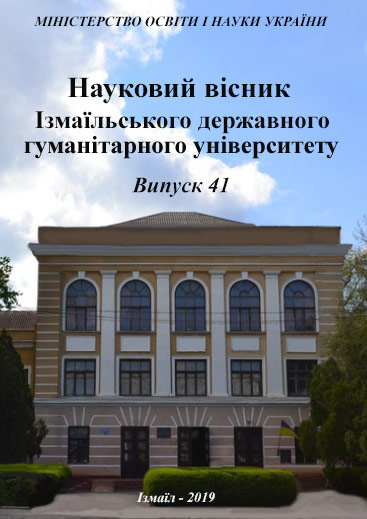The Tradition s of the Middle Ages Religious Drama in J. Bunyan Fictions
Abstract
The article deals with the comprehension of the phenomenon of theatricality of baroque art
text, which is not dramatic on the basis of J. Bunyan creativity. Aesthetic and philosophical views of
the English writer are reflected in the context of spiritual quest in the English literature of the XVIIth
century, so as the methodological aspects of intermediate studies. Dramatic elements in J. Bunyan’s
works are related to the creation of philosophical and religious worldview with philosophical ideas
and images. The author considers the category of theatricality as a presence in the fiction of the
characteristics of drama genres special patterns: theater timespace; ―stage‖ deployment of action;
performance and image characters; acting components in the text; elements of foolishness, richness
of signs and impressions.
It is proved that J. Bunyan’s artistic heritage originates from liturgical medieval morality
drama. The traditional for medieval poetry concept of the sky is revealed by the notion of Nebesnyy
grad, where righteous men live, who managed to avoid the temptation of this world. The perception
of English preacher of rescuing is restricted by medieval key point about sinfulness of flesh and
confined to the picture of realization of earthly pleasure on unearthly disembodied level. In the works
of J. Bunyan detached stories (parables, fables, recollections) are of specific value, they play the role
intermedias, that perform an expressive didactic function. The author is also char acterized by
various demonstration of «author’s mask» and sequencing of certain «mask» of his characters. The
image of a Christian is an expressive person of J. Bunyan and Christians are to his earthly wife.
The theatricality of J. Bunyan’s discourse is also predetermined by the specifics of baroque
worldview, the typical character of theatricalizing of artistic image in baroque artistic thinking, that
was personalized in the thesis «world like a theatre» (Shakespeare), «world like a dream»
(Calderon) and others in European artistic practice. The organization of state events and ceremonies
as theatricalized acts, strict following to the rules of etiquette led to the vanishing of the bound
between life and theatre. The actual for baroque aesthetics motives o f disharmonic world and loss of
an individual in it are revealed effectively by the means of theatricalizing of artistic discourse.
Theatricality as a form of specific existence of culture and phenomenon of artistic discourse in the
works of nondramatic genres made it possible to create a new type of artistic creativity, connected
with the phenomenon of theatricalizing of literary consciousness.
The introduction of dramatic elements in the works of J. Bunyan, that is not dramatic
according to its genre property, allows to create inherent in European-wide area components of
baroque artistic thinking paradigm: philosophical ideas and images become characters, with whom
the associative-semantic play is not only a specific feature of individual artistic method of masters,
but it also allows to establish the models of philosophical-religious picture of the world within the
theatricalized artistic thought. The characteristic features of these models are playing transformation
of time and spacious layers of realit y, their inter-penetration, the idea of illusory forms of being that
is associated with staged, theatrical space.


